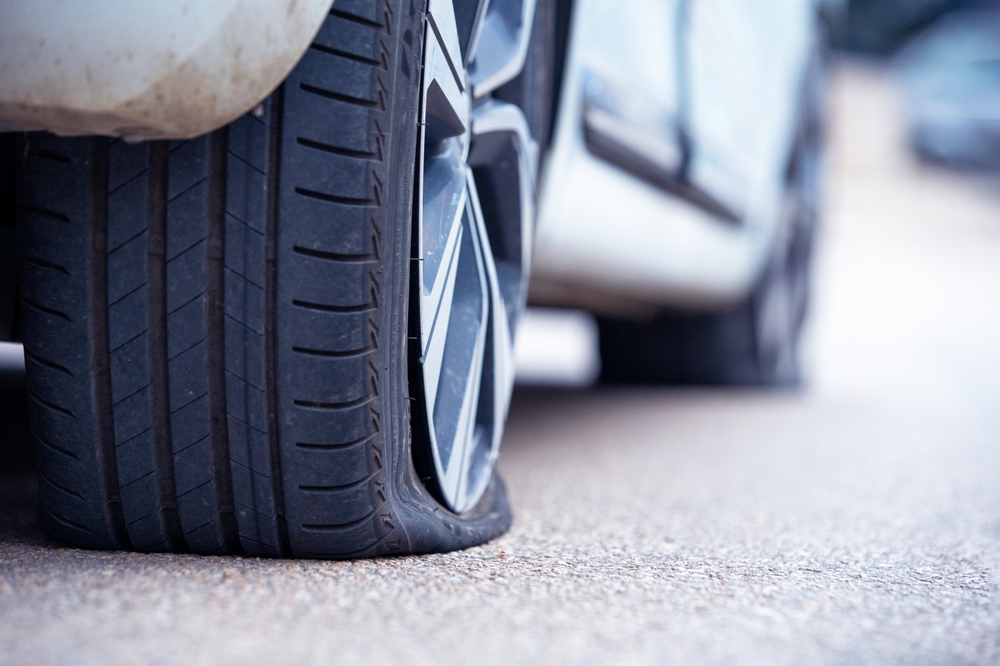Why You Can’t Drive with a Flat Tyre & What to Do Instead?

You’re on your way, coffee in one hand, tunes on the stereo. When suddenly, thud! Your car starts to wobble. You pull over and step out to check. Yup, it’s a flat tyre.
Now the first question that hits your mind even before thinking about solution is: How long can you drive on a flat tyre? You need to limp to the nearest mechanic, or even want to reach your destination & leave the problem for later.
But is it safe? Is it even legal? Let’s find out with Morley Tyre Centre.
Can You Drive with a Flat Tyre at All?
Technically, yes, for a couple of metres. But that doesn’t mean you should keep dragging your vehicle as long as possible. As it’s like walking on a broken ankle. You can complete a few steps, but on the stake of bigger trouble.
Experts agree you should never drive with flat tyre unless you’re moving the car just a few metres to a safer spot, like out of a live traffic lane.
Another common question is:
How far can you drive on flat tire?
Well, to be precise, no more than 60 to 120 metres, and even that comes with risks. The longer you go, the more you damage the tyre, wheel, and other parts.
Be it safety, money, or damage you care about, driving on flat tyre is a bad gamble.
Let’s talk about the damages in detail.
5 Possible Damages When You Drive on a Flat Tyre
Here are some reasons why driving on a flat tyre is simply not worth it.
1. It Can Damage Your Tyre Beyond Repair
When you drive with a flat tyre, you crush the tyre’s internal structure. The rubber folds, pinches, and eventually tears. Even if you think you can patch it up later, chances are the internal cords and sidewalls will be beyond repair.
2. It Damages Your Rim and Suspension
The rim isn’t meant to roll directly on the ground. If you keep driving with a flat tyre, the weight of the car on the bare wheel can cause it to bend or crack. Worse yet, it can throw your suspension, wheel alignment, and brakes out of whack.
3. You Lose Control of Steering & Braking
A flat tyre kills your vehicle’s balance and traction. That means longer stopping distances, delayed steering, and poor handling. And that’s a recipe for huge disasters.
4. The Tyre Can Blowout
A flat tyre is already weakened, and driving on it only worsens things. The extra heat and friction can cause it to completely tear apart, which is extremely dangerous at high speeds.
5. A Road Accident Can Be Caused
When you can’t steer your vehicle in the required direction & can’t stop it when you want, an accident is more than probable. Especially if you drive with a flat tyre on busy roads, wet conditions or faster lanes.
What About Run-Flat Tyres?
Run-flat tyres are built to do exactly what their name suggests, run when flat. So, many people ask, can you drive with flat tyre if you have a run-flat model?
Well, it depends on their quality, type of road & your speed. Most manufacturers cap it at 80 km at 50 km/h. You shouldn’t exceed your speed from 80km/h in any case.
Run flat tyres are reinforced with tougher sidewalls that support the vehicle even when air pressure is lost. They’re great for buying time, but not a permanent fix. And keep in mind, they are more expensive and aren’t suitable for all cars.
How to Tell If You’ve Got a Flat Tyre? 5 Signs
Not every flat announces itself with a loud noise. Sometimes it’s a slow deflation, and you don’t even know that you are driving on flat tyre until your steering feels weird.
Here are signs to watch for:
- Pulling to one side when driving
- Vibrations in the steering wheel or floor
- A soft or slouchy look on one tyre
- Dashboard tyre pressure warning light
- Slower braking or poor handling
So, whenever you notice any of these signs, pull over to the side of road and check your tyres. Are any of them appearing flat? If yes, what to do? Well, let’s first talk about what not to do.
Mistakes to Avoid When You Have a Flat Tyre
First of all, don’t panic! And avoid these mistakes made by almost every driver.
- Don’t keep driving “just a bit farther”. You can cost yourself hundreds in wheel damage.
- Don’t move fast if you have to drive with a flat tyre for reaching a safer spot.
- Don’t jack up the car on uneven ground. Always make sure your car is stable and secure before lifting it.
- Don’t use a space saver spare like a full tyre. It’s meant for temporary use only.
- Don’t ignore your spare’s pressure. Yes, they need air too!
Trust us we’ve seen a lot of drivers doing these and paying heavy price later. So, avoid them at all costs. Then, what is the correct plan of action in case of flat tyre? Read on.
What to Do at the Moment You Spot a Flat Tyre?
Here are the important steps you should follow when you get a flat tyre.
Step | Detail |
Pull Over Safely | Find a flat area well off the road, avoid soft or sloped surfaces. |
Switch on Hazards | Let other drivers know you’ve stopped. |
Inspect the Damage | If the tyre is shredded or the rim is bent, don’t drive at all. |
Call for Help or Change It Yourself | You can reach out to nearby tyre specialists if possible or change it yourself. |
Don’t know how to change a tyre? Here is our guide to help you in emergency situations.
Changing a Flat Tyre | Quick & Easy Process
When you’re stuck with a flat tyre and deserted road, you’ll need a little knowledge yourself. Even if you’ve never done it before, changing a flat tyre is doable with a little patience and expert guidance.
Tools You’ll Need:
- Jack
- Lug wrench
- Spare tyre (inflated)
- Wheel wedges (optional but helpful)
Step-by-Step Process:
- Park on a firm & flat surface on a safe corner.
- Loosen the lug nuts (don’t remove them yet).
- Use the jack to lift the vehicle (check your manual for the exact spot of jack attachment).
- Remove the flat and place it aside.
- Mount the spare onto the bolts.
- Hand-tighten the nuts, lower the car, then tighten in a crisscross pattern.
- Check that the tyre is inflated to the correct pressure.
- Drive to trusted tyre experts like Morley Tyre Centre for a permanent fix.
Is there Any Other temporary Solution Than Spare Tyres?
If you don’t have properly inflated spare tyre at the moment, got multiple flat tyres or simply don’t know how to change. The other temporary solutions can also help you.
One common method is using a tyre sealant, which can be sprayed into the valve to temporarily seal small punctures from the inside. It works best for minor tread punctures and allows limited driving to a nearby repair shop.
Modern vehicles also contain tyre repair kits. That have sealant and a small air compressor to re-inflate the tyre enough to get you moving. However, it isn’t suitable for large punctures or sidewall damage.
Permanent Fixes for a Flat Tyre
Temporary fixes can get you rolling, but they’re not long-term solutions. And you can’t drive on stepney for days. Let’s explore the permanent solutions.
1. Tyre Plug or Patch
For small punctures (like a nail), a plug or patch can safely seal the leak. This must be done professionally to meet safety standards.
2. Tyre Replacement
If the damage is on the sidewall or the tyre is too worn, replacement is your best bet. At Morley Tyre Centre, we stock tyres for all vehicle types. Passenger, SUV, 4×4, electric, and even light trucks.
Got a Flat and Searching for Puncture Shops in Perth?
Get Flat Tyre Fixes & More at Morley Tyre Centre
At Morley Tyre Centre, we keep you moving. Our crew knows what a flat tyre can do to your vehicle and how risky driving on a flat tyre can be. We can help you with a flat tyre and offer the right replacements if needed.
Need a quick check-up? Wondering if that slow leak’s safe to drive on? Drop in anytime.
We’re proudly local, fast, and friendly, the kind of team you’d want on your pit crew.
